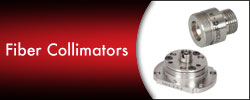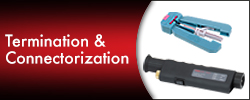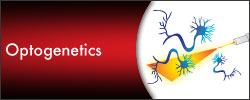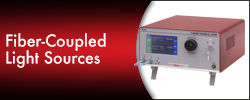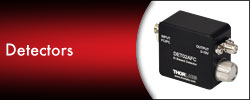
Custom Fiber Optic Patch Cables
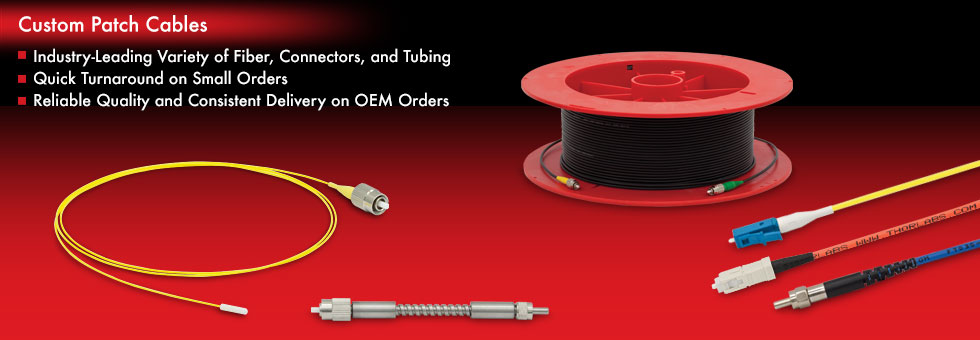
FIBER OVERVIEW
Fiber Optic Cable Structure
General Fiber Information
A fiber optic cable is made of 5 main parts, labeled in the figure to the right. The core, made of glass or plastic, provides the path for light propagation. Larger core sizes allow a greater amount of light, or a larger beam diameter, to enter the fiber. The numerical aperture (NA) of the core determines the range of incident angles the fiber can accept and still perform within its specified range. The cladding prevents light from exiting the core and being absorbed by the rest of the cable. The coating, or buffer, protects the core and cladding and provides strength. The next layer of the cable is a material, such as Kevlar, that reinforces the cable and helps prevent damage due to stress. The entire package is then encased in a jacket. This outer jacket provides one last layer of protection and also adds strength to the fiber. The jacket is typically colored to help the user determine what type of optical fiber is in the cable.
Thorlabs follows the industry standard in jacket coloration. We use a yellow jacket for our Single Mode (SM) fibers, an orange jacket for our Multimode (MM) fibers, and a blue jacket for our Polarization Maintaining (PM) fibers. Our custom patch cables can be made with any jacket color / fiber combination. Some Ø900 µm jackets are avaliable only in lengths up to a certain maximum as shown in the table below.
| Jacket Lengthsa | |||||
|---|---|---|---|---|---|
| Item # | FT900Y | FT900SM-BLUE | FT900KY | FT900KB | FT900KK |
| Maximum Length | <5 m | <3 m | <10 m | <10 m | <10 m |
FIBER OPTIONS

Click to Enlarge
Patch Cable Inspection at Thorlabs in Newton, NJ
Building Your Custom Patch Cable
Have you looked through our broad selection of stocked patch cables to see if one of them meets your needs? If none of the stocked options are what you are looking for, a custom cable can be manufactured.
Select a Fiber
Thorlabs offers four major types of fiber: Single Mode (SM), Multimode (MM), Polarization Maintaining (PM), and Doped. Each fiber type is explained in detail below. You will also find a complete list of all the fibers that we offer for our custom patch cables along with key specifications that may help you decide which fiber is best for your application. We sell all of these fibers individually on our website as well, along with a wide variety of others. Click here to view all of the fiber options Thorlabs offers. Please contact Tech Support if you have any other questions about our fiber.
Light Propagation Down Single Mode Fiber
Single Mode (SM) Fiber
SM fiber has small core sizes that only allow one mode, or ray, to propagate through the fiber. The mode defines how the light travels through space. Light propagates along the axis of the fiber in this single mode (see drawing to the right). In SM fiber, waves have the same mode but different frequencies. This type of fiber is useful in situations where the integrity of the incident pulse of light needs to be retained over long distances. SM fiber offers high bandwidth and low modal dispersion.
Photosensitive SM Fiber
Photosensitive single mode fiber is designed to provide high photosensitivity for UV radiation. These fibers offer lower splice loss than standard SM fibers and are suitable for a range of applications. For more information about these fibers, click here.
| Photosensitive SM Fiber Options |
|---|
| SM Fiber Options |
|---|
* Cladding: Ø80 µm
** Ø900 µm Jacket
| Ultra High NA SM Fiber Options |
|---|
Light Propagation Down Step-Index Multimode Fiber
Light Propagation Down Graded-Index Multimode Fiber
Multimode (MM) Fiber
The larger core diameters of multimode (MM) fiber allow for the propagation of more than one mode. Light not only propagates along the axis of the fiber, as in SM fiber, but also travels away from the axis toward the cladding (see animations to the right). The total internal reflection that occurs at the core-cladding boundary helps reflect the light back towards the fiber axis. MM fiber tends to have a higher NA and larger core sizes than SM fiber, which allows it to gather larger beams of light at greater incident angles. It has lower bandwidth than SM fiber and is susceptible to modal dispersion.
Modal dispersion is a distortion of the incident light pulse caused by the fact that the propagation velocity of the different modes varies. Due to the “zigzag” path the modes take to travel down the fiber, the modes that zigzag more take longer to reach the end than those that travel in a straighter path. When all modes, both fast and slow, combine again at the other end of the fiber, the pulse is widened.
There are two main types of MM fiber: Step Index and Graded Index. The core in a step-index fiber has a uniform refractive index throughout. There is a sharp decrease in refractive index at the core-cladding boundary where the cladding refractive index is lower than that of the core. This results in the modes traveling down the fiber in a very jagged path (see animation to the right). Step-index fiber is generally made by doping the fiber with another material.
The refractive index of the core in a graded-index fiber decreases as the distance to the center of the core increases. This results in a much smaller change in the refractive indice at the core-cladding interface. The smoother transition causes the modes to travel in sinusoidal paths down the fiber (see animation to the right). Graded-index fibers have much lower modal dispersion than step-index fibers. The parabolic wave profile of the modes continuously re-focuses the rays. Those traveling straight down the center of the fiber travel much slower than those traveling in a more sinusoidal path due to the differences in refractive index. The resulting pulse is less spread out and very close in profile to the incident one.
Solarization-Resistant MM Fiber
Solarization-Resistant multimode fiber exhibits impressive performance and transmission from the UV to the NIR (180 to 1150 nm). With exceptional UV radiation resistance compared to standard fibers, these multimode fibers are ideal for use in applications such as spectroscopy for pollution analysis and chemical processing, UV photolithography, and medical diagnostics. The polyimide buffer allows this fiber to be used at temperatures up to 300 °C. For more information about these fibers, click here.
| High OH Step-Index MM Fiber Options |
|---|
| Graded-Index MM Fiber Options |
|---|
| Low OH Step-Index MM Fiber Options |
|---|
| Solarization Resistant Step-Index MM Fiber Options |
|---|
Polarization-Maintaining (PM) Fiber
The polarization of incident light is maintained during propagation through polarization-maintaining (PM) fiber. There are many types of PM fibers, but they all work the same way: stress is induced in the core via rods within the cladding. The stress aligns the fiber, and the light, to a particular polarization. Thorlabs offers two types of PM fiber: PANDA style and Bow-Tie style. The types are named for the shape of the stress rods incorporated into the fiber (see drawing to the right). PM fiber is used in fiber optic sensing, interferometry, and quantum key distribution. It is also commonly found in telecommunications applications connecting a laser source and a modulator. PM fiber has higher attenuation than SM and MM fibers.
It is important to note PM fiber does not polarize the incident light; rather, it just maintains the existing polarization of the light that is aligned with the stress rods. The fiber key is aligned during the manufacturing process to ensure high-quality output, as evidenced by the polarization extinction ratio (PER). A higher PER indicates that the light exiting the fiber has a polarization that is more consistent with that of what entered.
| Bow-Tie Style PM Fiber Options |
|---|
| Photosensitive PM Fiber Options |
|---|
| PANDA Style PM Fiber Options |
|---|
| Polarizing Fiber Optionsa |
|---|
| Spun Fiber Optionsa |
|---|
Doped Fiber
| Erbium-Doped SM Fiber Options |
|---|
Erbium-Doped SM Fiber
Our wide range of highly doped erbium fibers are suitable for fiber lasers and amplifiers operating in the 1530 to 1610 nm wavelength region. These fibers are utilized in a broad range of applications, ranging from telecommunication amplifiers (EDFAs) to high-power PON/CATV boosters and ultra-short pulse amplifiers used in instrumentation, industrial, and medical applications. For more information about these fibers, click here.
| Double Clad Ytterbium-Doped MM Fiber Options |
|---|
Ytterbium-Doped MM Fiber
Thorlabs offers state-of-the-art Ytterbium doped optical fibers for optical amplifiers, ASE light sources, and high-power pulsed and CW fiber laser applications. These fibers are fabricated using the latest doped fiber production technology. For more information about these fibers, please click here.
| Passive Double Clad Fiber Options |
|---|
Passive Double Clad Fiber
Thorlabs' passive large-mode-area (LMA) fibers are matched to the core diameters and numerical apertures of their active counterparts to maintain excellent beam quality throughout fiber laser or amplifier systems. The outer cladding diameter is designed to "round" the shaped active fibers, thereby achieving low pump coupling loss from passive to active fibers. The passive fibers are coated with low-index fluoroacrylate enabling active fibers to be pumped through them. For more information about these fibers, click here.
CONNECTOR OPTIONS
Choose a Connector
A connector terminates the end of an optical fiber and enables quick, easy connection and disconnection. The connectors mechanically couple and align the cores of the fibers so that light can pass from one to the other unobstructed. Thorlabs offers a flat-cleave option as well as 6 narrow key connectors for our Custom Patch Cables.
Flat-Cleave
A flat-cleave is a carefully controlled break in the fiber perpendicular to the fiber axis, resulting in a flat end face. No connector is attached to the fiber. A flat-cleave allows for bare fiber connection. Flat-Cleaves are ideal for mechanical or fusion splicing or free space applications without the use of a connector.
Scissor Cut
A scissor cut is a very quick cut that will not produce an even output or splice surface on the end of the fiber. This cut is ideal for the user who is proficient in cleaving fibers or intend to terminate a fiber with their own connector. The end of a scissor cut fiber must be cleaved and connectorized before it can be used.
FC/PC Connectors
The threaded FC/PC connector is designed for high vibration environments. The "PC" stands for "physical contact" because this connector allows the fibers' surfaces to be in direct contact with each other at the connector interface. The ceramic or stainless steel ferrule, or end, of an FC/PC connector is spring loaded to control the force on the fiber as the connector is screwed into its port.
Single Mode FC/PC Connectors


Our single mode (SM) FC/PC connector features a pre-radiused (R20 mm) ceramic ferrule to help minimize back reflections. The SM FC/PC connector has a hole size tolerance of +1/-0 µm and a maximum concentricity of 1 µm.
Multimode FC/PC Connectors


Our multimode (MM) FC/PC connector has a precision-drilled bore to match the fiber diameter and a maximum concentricity of 3 µm.
Polarization-Maintaining FC/PC Connectors


For Polarization-Maintaining (PM) fibers, we offer a FC connector with a continuously adjustable key to allow you to rotate the back of the connector to align to the slow or fast axis of the fiber. Once the connector is aligned, you can lock it in place with a drop of superglue. If you purchase a PM fiber cable that is aligned by us, the connector key will be aligned to your specification.
FC/APC Connectors


This connector has the same basic design as the FC/PC connector, but the fiber end is polished at an angle. This “Angled Physical Contact” (APC) interface prevents light reflected at the fiber-fiber junction from traveling back up the fiber. FC/APC connectors only mate properly with other FC/APC connectors. Mating FC/APC with any other connector results in high insertion loss. These connectors minimize back reflections but have a higher insertion loss than their FC/PC counterparts.
All of our FC/APC connectors offer a minimum back reflection of -65 dB due to the nature of the APC end. Thorlabs' APC connectors are distinguished by the use of a green strain relief boot.
SMA Connectors


Our subminiature version A (SMA) connectors are used for large core, multimode fibers. These connectors are threaded like our FC/PC and FC/APC connectors. We stock SMA connectors for fibers with cladding diameters ranging from 125 to 1580 µm.
ST® Connectors
Straight Tip (ST) connectors have a bayonet-style mount that allows for quick connects and disconnects but does not seat the fiber as well as other connections.


Our single mode (SM) ST connector features a ceramic ferrule with a pre-radiused tip (R20 mm) to minimize back reflections. The ST connectors feature a concentricity of maximum 1 µm.
We also carry ST-style connectors designed for multimode (MM) applications. Our standard connectors have a bore size of 140 µm but we also carry a full supply of drilled conectors to meet custom requirements. These connectors feature a maximum concentricity of 1 µm.
*ST® is a registered trademark of Lucent Technologies, Inc.
SC Connectors


Subscriber Connector (SC) connectors are snap-in connectors that are easy and quick to use. Our SC-style connectors, which have a bore size of Ø125 µm, feature a pre-radiused (R20 mm) ceramic ferrule to help minimize back reflections.
LC Connectors


Lucent Connectors (LC) are similar to SC connectors but contain ferrules that are half the size of those found on SC connectors. We stock LC connectors for single mode fibers. Multimode LC connectors for fiber claddings up to Ø127 µm are available upon request. Due to their small size, they are ideal for situations where a large number of connectors are used in a small space.





